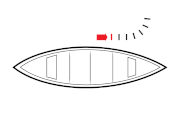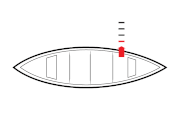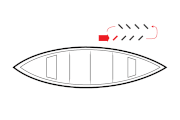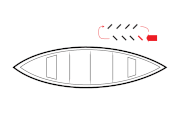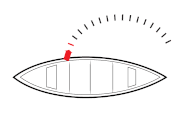
A kayak is a small, narrow human-powered watercraft typically propelled by means of a long, double-bladed paddle. The word kayak originates from the Greenlandic word qajaq.
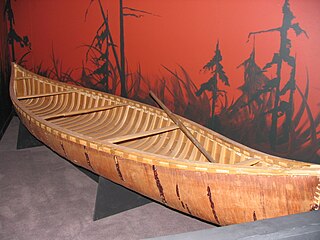
A canoe is a lightweight narrow water vessel, typically pointed at both ends and open on top, propelled by one or more seated or kneeling paddlers facing the direction of travel and using paddles.

A paddle is a handheld tool with an elongated handle and a flat, widened distal end, used as a lever to apply force onto the bladed end. It most commonly describes a completely handheld tool used to propel a human-powered watercraft by pushing water in a direction opposite to the direction of travel. It is different to an oar in that the latter is attached to the watercraft via a fulcrum.
A dragon boat is a human-powered watercraft originating from the Pearl River Delta region of China's southern Guangdong Province. These were made of teak, but in other parts of China different kinds of wood are used. It is one of a family of traditional paddled long boats found throughout Asia, Africa, the Pacific islands, and Puerto Rico. The sport of dragon boat racing has its roots in an ancient folk ritual of contending villagers, which dates back 2000 years throughout southern China, and even further to the original games of Olympia in ancient Greece. Both dragon boat racing and the ancient Olympiad included aspects of religious observances and community celebrations, along with competitions.

A jibe (US) or gybe (Britain) is a sailing maneuver whereby a sailing vessel reaching downwind turns its stern through the wind, which then exerts its force from the opposite side of the vessel. Because the mainsail boom can swing across the cockpit quickly, jibes are potentially dangerous to person and rigging compared to tacking. Therefore, accidental jibes are to be avoided while the proper technique must be applied so as to control the maneuver. For square-rigged ships, this maneuver is called wearing ship.
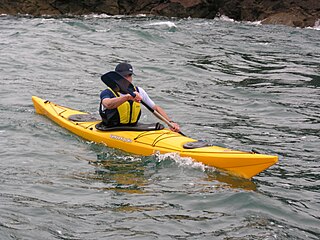
A sea kayak or touring kayak is a kayak used for the sport of paddling on open waters of lakes, bays, and oceans. Sea kayaks are seaworthy small boats with a covered deck and the ability to incorporate a spray deck. They trade off the manoeuvrability of whitewater kayaks for higher cruising speed, cargo capacity, ease of straight-line paddling (tracking), and comfort for long journeys.

A setting pole or quant is a pole, handled by a crew member, to move boats, barges or punts by pushing the craft in the desired direction. The pole is used to push against the river or sea bed or, in some cases, the bank of the river. If used from the stern of the craft, the action is usually called "punting." Especially on larger vessels, it is more effective if the operator starts at the bow and walks aft along a side deck, pushing against the bottom all the way – this action is called "quanting" or "setting". If there is a short stretch where the water is too deep for the pole to reach the bottom, the pole can be used as a paddle. Whilst this is substantially less effective than a bladed oar or paddle, it is sufficient to keep the boat moving.

Whitewater kayaking is an adventure sport where a river is navigated in a decked kayak. Whitewater kayaking includes several styles. River running; where the paddler follows a river and paddles rapids as they travel. Creeking usually involving smaller, steeper, and more technical waterways. Creek boats tend to be short but high volume to allow for manoeuvrability while maintaining buoyancy. Slalom requires paddlers to navigate through "gates". Slalom is the only whitewater event to be in the Olympics. Play boating involves staying on one feature of the river and is more artistic than the others. Squirt boating uses low-volume boats to perform special moves in whitewater features.
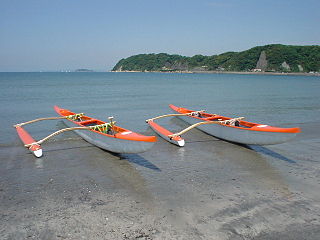
Outrigger boats are various watercraft featuring one or more lateral support floats known as outriggers, which are fastened to one or both sides of the main hull. They can range from small dugout canoes to large plank-built vessels. Outrigger boats can also vary in their configuration, from the ancestral double-hull configuration (catamarans), to single-outrigger vessels prevalent in the Pacific Islands and Madagascar, to the double-outrigger vessels (trimarans) prevalent in Island Southeast Asia. They are traditionally fitted with Austronesian sails, like the crab claw sails and tanja sails, but in modern times are often fitted with petrol engines.
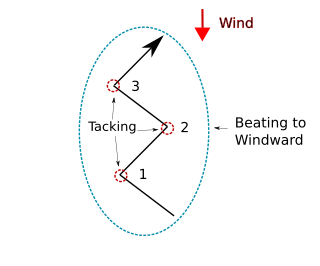
Tacking or coming about is a sailing maneuver by which a sailing craft, whose next destination is into the wind, turns its bow toward and through the wind so that the direction from which the wind blows changes from one side of the boat to the other, allowing progress in the desired direction. Sailing vessels are unable to sail higher than a certain angle towards the wind, so "beating to windward" in a zig-zag fashion with a series of tacking maneuvers, allows a vessel to sail towards a destination that is closer to the wind that the vessel can sail directly.

Rowing is the act of propelling a human-powered watercraft using the sweeping motions of oars to displace water and generate reactional propulsion. Rowing is functionally similar to paddling, but rowing requires oars to be mechanically attached to the boat, and the rower drives the oar like a lever, exerting force in the same direction as the boat's travel; while paddles are completely hand-held and have no attachment to the boat, and are driven like a cantilever, exerting force opposite to the intended direction of the boat.
In competitive rowing, the following specialized terms are important in the corresponding aspects of the sport:

Squirt boating is a form of whitewater kayaking where the boat is designed to be as low in volume as possible while still allowing the paddler to float. Squirt boats are designed to use both surface and underwater currents to maneuver within the water. These maneuvers can be used to effect navigational control or to perform tricks.

A punt is a flat-bottomed boat with a square-cut bow, designed for use in small rivers and shallow water. Punting is boating in a punt; the punter propels the punt by pushing against the river bed with a pole. Punts were originally built as cargo boats and as platforms for fowling and for fishing, such as angling; whereas now punting is boating for pleasure.
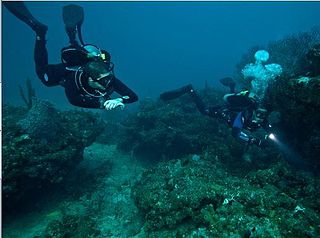
Finning techniques are the skills and methods used by swimmers and underwater divers to propel themselves through the water and to maneuver when wearing swimfins. There are several styles used for propulsion, some of which are more suited to particular swimfin configurations. There are also techniques for positional maneuvering, such as rotation on the spot, which may not involve significant locational change. Use of the most appropriate finning style for the circumstances can increase propulsive efficiency, reduce fatigue, improve precision of maneuvering and control of the diver's position in the water, and thereby increase the task effectiveness of the diver and reduce the impact on the environment. Propulsion through water requires much more work than through air due to higher density and viscosity. Diving equipment which is bulky usually increases drag, and reduction of drag can significantly reduce the effort of finning. This can be done to some extent by streamlining diving equipment, and by swimming along the axis of least drag, which requires correct diver trim. Efficient production of thrust also reduces the effort required, but there are also situations where efficiency must be traded off against practical necessity related to the environment or task in hand, such as the ability to maneuver effectively and resistance to damage of the equipment.

A war canoe is a watercraft of the canoe type designed and outfitted for warfare, and which is found in various forms in many world cultures. In modern times, such designs have become adapted as a sport, and "war canoe" can mean a type of flatwater racing canoe.

Creeking is a branch of canoeing and kayaking that involves descending very steep low-volume whitewater. It is usually performed in specialized canoes and kayaks specifically designed to withstand the extreme whitewater environment in which the activity occurs. In addition, the canoes and kayaks give the paddler improved performance and maneuverability needed to avoid river obstacles.

A raft guide is a trained professional capable of leading commercial white water rafting trips. Most raft guides are employed by commercial outfitters who run either multi- or single-day trips.

Whitewater canoeing is the sport of paddling a canoe on a moving body of water, typically a whitewater river. Whitewater canoeing can range from simple, carefree gently moving water, to demanding, dangerous whitewater. River rapids are graded like ski runs according to the difficulty, danger or severity of the rapid. Whitewater grades range from I or 1 to VI or 6. Grade/Class I can be described as slightly moving water with ripples. Grade/Class VI can be described as severe or almost unrunnable whitewater, such as Niagara Falls.

Stern sculling is the use of a single oar over the stern of a boat to propel it with side-to-side motions that create forward lift in the water. The strict terminology of propulsion by oar is complex and contradictory, and varies by context. Stern sculling may also simply be referred to as "sculling", most commonly so in a maritime situation. In fresh water, and particularly in sport rowing, sculling is use of two oars on either side of the boat by each person, in contrast to sweep rowing, whereby each boat crew member employs a single oar, complemented by another crew member working on the opposite side with their oar.


